Tuesday, January 30, 2018
(Teaching & Troubleshooting) Basic Breakouts
For sure, breakout plays can be designed to be pretty sophisticated. However, ask any high level coach about the real key to breakout success, and he or should will likely tell you it relies heavily on execution.
That said, I'd like member players, parents and coaches to pay particular attention to the so-called "little things" I point-out in the following video. For, I think an awareness of these skills -- from both a physical and mental perspective -- can make a profound impact on any individual's or team's ability to move the puck out of their end. Then, once you've seen the video, I'd like to add a few more comments (below)...
http://coachchic2.s3.amazonaws.com/BreakoutBasics.mp4
Now that you've had a chance to watch that video, I'd like to emphasize a few things...
As you'll catch me saying often, playing the game well calls for great skills and an ability to think the game. (Believe it or not, I occasionally run across folks at local arenas who feel players can avoid one or the other and still excel.)
As I said in the video, skill-wise a player needs to be able to skate his or her position, handling the puck under pressure is essential, and it's also an absolute necessity that players make and catch passes.
It should also be evident that players can't just close their eyes and fire the puck in some general direction. In fact, I made the point that we would like to fool the opposition forecheckers when possible, and that the first pass in our zone is especially important.
Finally, because the breakout is actually a combination of many skills and thought processes, look for me to add a number of new videos in coming months, these focusing in more depth on each small breakout part.
Tried and True Hockey Principles
It never stops amazing me, that even pro hockey players have so-called "brain freezes" during the heat of battle. And, while that might not be why I began compiling something on the order of my tried and true principles, it's surely a good enough reason.
-- Dennis Chighisola
Tried and True Hockey Principles
Actually, that "Tried and True Hockey Principles" thingy wasn't even what I called the list I compiled years ago for the sake of my NEHI players. But, let me tell my member friends a little about the background to all this...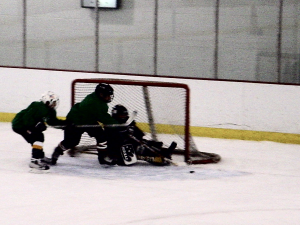 Now, if any coaching members can recall their earliest years on the job, you probably remember being a little (or maybe a lot) unsure of yourself. I don't mean that you necessarily lacked confidence, but there's a good chance you did find it difficult to challenge some long standing principles you'd heard for years.
Now, if any coaching members can recall their earliest years on the job, you probably remember being a little (or maybe a lot) unsure of yourself. I don't mean that you necessarily lacked confidence, but there's a good chance you did find it difficult to challenge some long standing principles you'd heard for years.
That's what I recall going through... I'd find myself noticing something happening countless times during games -- like some things of real consequence, and wonder why the heck no one else ever noticed it, or at least mentioned it. Some might find that stuff easy to dismiss, but not this stubborn young coach (at the time).
Going back to the late-70s, I studied video incessantly. So, when I sensed I saw something on tape that was of consequence, I replayed and replayed a given segment until I was pretty sure of what was happening. I wouldn't stop there, though, also searching for other examples so I could be absolutely positive about what I was seeing.
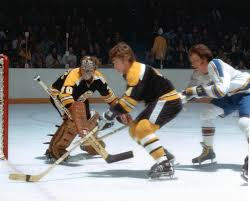 Some of the video I studied was of my own team at the time, but I'd also record televised pro games so I could study those (until my eyes blurred). That's how one builds confidence in his or her convictions, ya know, by studying and studying and...
Some of the video I studied was of my own team at the time, but I'd also record televised pro games so I could study those (until my eyes blurred). That's how one builds confidence in his or her convictions, ya know, by studying and studying and...
As it turned out, a combination of my own finds and others most coaches would describe as tried and true hockey principles started to mount, and it also turned out that I needed to somehow address them with the players in my charge.
I'll explain the latter in awhile, but for now let me say that my biggest early challenge was in naming the slow building list. Hmmmmm... In the end, the best I could do was call them "Coach Chic's Rules for Winners".
Okay, the following list has sometimes grown to be twenty-ish in length. Still, here's the basic list of tried and true hockey principles I addressed at least once per week with my kids...
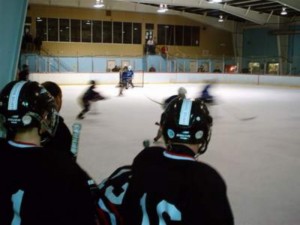
Coach Chic's Rules for Winners
1) Immediate pressure rattles opponents and gives us the puck!
2) Go over the boards to enter the ice; those coming off must also make it extremely easy for new players to get into the play!
3) In our zone, the best passes are lateral and ahead.
4) The next center always replaces the goaler on delayed penalties.
5) These are your options when carrying the puck up-ice:
- #1 - "Head-man" to advance the attack fastest;
- #2 - Carry (if you're not out-manned);
- #3 - Dump (if out-manned or we are leading); or
- #4 - Enter the offensive zone and protect the puck until help arrives.
6) Effective dump-ins provide an advantage for your teammates.
7) Our form of BACKCHECKING means totally smothering the attack -- controlling bodies and especially controlling sticks!
8) On Powerplays:
- Never go off-side;
- Protect the puck and only pass to unguarded teammates;
- When we lose the puck, two players must immediately check the puckcarrier, with all other players covering an open man.
- See Point #12 below.
9) Show "coolness" at all times, no matter what happens!
10) Focus on the body and... Finish ALL checks!!!
11) Always know what's happening with the puck... "head on a swivel".
12) Avoid hard shots from the point on one side of the ice aimed towards the net-corner on the other side (these shots too often go wide of the net, hit the corner boards, and fly out of the offensive zone).
My players got a photocopied list during our summer workouts, besides having that list posted on our team website. At the top of the list, I asked players to "Please study all of these". I also let the kids and parents know that many of the key principles would be explained in videos found on our site (and I believe I'll hunt down those videos and make sure they're available to CoachChic.com members).
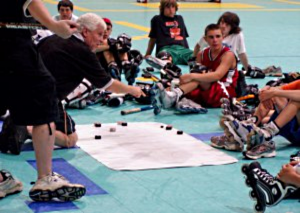 As I've mentioned quite a few times in earlier posts, my High School Prep and Junior High School teams practiced on Saturdays morning throughout the season at an awesome roller rink. That was a great place to walk through plays -- because it had all the rink markings, it was great to use as a gym for real physical workouts, we took advantage of training on in-lines, and it was also great for us to just relax on the floor and hold a weekly "bull session". And THAT is where the process started for my kids to ultimately be extremely smart players.
As I've mentioned quite a few times in earlier posts, my High School Prep and Junior High School teams practiced on Saturdays morning throughout the season at an awesome roller rink. That was a great place to walk through plays -- because it had all the rink markings, it was great to use as a gym for real physical workouts, we took advantage of training on in-lines, and it was also great for us to just relax on the floor and hold a weekly "bull session". And THAT is where the process started for my kids to ultimately be extremely smart players.
Just so members know, I've never been one to tell players that, "This is the way it is -- because I say so!" Naw, I want my players to be able to reason things much the way I arrived at them in the first place. This, I think, is a way of firmly embedding important principles in their minds, so that they'll remain there for years after I've coached them.
My guys knew that we'd be reviewing two or three of those points each Saturday morning, and they also knew they could be called upon to explain a given principle to the group. I'm not talking about embarrassing a kid, but as I said earlier, to make it kind of a "bull session" where we could discuss a principle under relaxed conditions.
 This aside... I discovered long ago that I have to understand something pretty deeply in order to be able to explain it to someone else. That was the case when I was coaching, and that's still going on with me today, as I have to really think things out carefully before I explain them here to my members. And so was it the case when one of my players had to explain a given principle to his teammates.
This aside... I discovered long ago that I have to understand something pretty deeply in order to be able to explain it to someone else. That was the case when I was coaching, and that's still going on with me today, as I have to really think things out carefully before I explain them here to my members. And so was it the case when one of my players had to explain a given principle to his teammates.Coach Chic's Rules for Winners
The idea for my "Rules for Winners" probably arose some 35 or more years ago. The way it started was that far back then, I'd started jotting some thoughts on things I believed made a difference in my team's games.
Anyway, at some point -- when I decided to collect all those ideas, print them, and then distribute them to my players, I realized I didn't have a title for the top of the page. So, while I'm not sure that my "Rules for Winners" is the best idea for a title, maybe I can at least explain my reasoning a little more down below.
-- Dennis Chighisola
Coach Chic's Rules for Winners
Okay, although I'd started gather my list of smart playing principles during the early-1970's, here's how things really got going... I purchased my first video unit in 1979 (can you believe that?), which was the same year I'd gone to study in the former Soviet Union. Both things tended to put me quite a ways ahead of other coaches of that time, but owning that video gear gave me the chance to study the game in a way that few of us from that era had ever been able to before.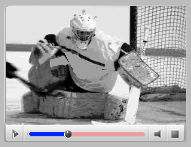
I was coaching a small high school program back then. And, despite the fact that we sometimes struggled to compete with several wealthier towns, gaining access to videos of those matchups was one of the best things that ever happened to my coaching career. I mean, just think about it: I was able to spend countless hours studying what was going right and (too often) wrong for my guys.
I actually took one game-tape and studied it to death, running and rerunning every single event, and listing on a deep stack of paper all the things that made a difference in that loss. And, let me tell you, that I gained a new respect for passing and pass receiving over that long week or so. As a matter of fact, I believe I listed something like in the high 200's for the number of mistakes that had been made in that area of our game.
So did some other things jump out and hit me between the eyes... I'm talking missed checks here -- some of them purely mental mistakes, and a number of problems on transition that ultimately led me to design a drill that even NHL coaches would use a few years later.

Where things got tricky was when I picked up something on video that I'd not previously heard other coaches say. I mean, there I was, a pretty young coach, and I'm wondering to myself why I'm seeing things that maybe my idols in higher levels hadn't ever mentioned -- in seminars or writings. Ya, talk about being a little nervous.
Still, all I could do was to keep watching my players, local college teams, and even the pros, and all I could do was keep studying videos until it became obvious that I was right. As a matter of fact, I started noticing that my ways of viewing the game -- and those things I was amassing as my Rules for Winners -- were obvious in tapes I'd even gathered from NHL games.
A lot of years have passed since '79, and my list of Rules has grown from just a few to about 20-ish. It's never been my aim to gather too many, though. For, what I'd really like is to list only those things that could make the greatest impact on a player's (or team's) game.
How have I used my Rules for Winners so far through the years? I'd say the best has been as part of a weekly off-ice session I held for my old HS Prep and Jr HS Teams. There, we'd sit and relax on a gym floor after a pretty good physical workout, and just shoot the bull about one of those Rules.
 My kids and I might gather on the gym floor, oftentimes around one of my Model Rinks. With that, I might toss out something like, "Hey, guys... Rule number six says we should try to avoid turning our back on the puck. Who can explain what's really meant by that?"
My kids and I might gather on the gym floor, oftentimes around one of my Model Rinks. With that, I might toss out something like, "Hey, guys... Rule number six says we should try to avoid turning our back on the puck. Who can explain what's really meant by that?"
I'm really hoping more than just a couple of kids will jump in on that. And, I don't even mind if someone goes off on a slight tangent, so long as it's making all my guys think, and as long as it's helping ingrain that day's topic. I might grab a stick and walk through a pattern where I do and then don't turn my back on the puck, and I won't mind if one of my kids offers to do the same.
Anyway, "Coach Chic's Rules for Winners" is not carved in stone. In fact, I would love if others jump in here, to offer something they see as having a big impact on game results. Sometime shortly, I hope to publish a really good list, including my ideas and the best from others. So...
Post your idea for what you believe is a solid playing principle over on our CC Hockey Message Board!
It's FREE!
Troubleshooting Hockey Backchecking
A Pee Wee level coach was looking for help recently in a hockey forum. And, after noticing few others offered him anything that would really work, I decided to help here, troubleshooting the problem his kids seem to be having with their backchecking.
The young coach, Michael B, is from Wisconsin, and he says his players are mostly 12-years old.
-- Dennis Chighisola
Troubleshooting Hockey Backchecking
Whenever I try troubleshooting something long distance, I usually need to know a few things in order to get a better feel for the real problem/s. That in mind, I shot off these three questions to the young coach...
1) How much about backchecking do you think your kids truly know?
2) What have you done so far with them in this area?
3) What are the kids actually doing (wrong) in their games?
Michael answered back, noting that, "So far all I have been trying to get them to do is come back and attack the other team. In practice they do well. In games they tend to think the d will take care of it. They allow the other team to skate through with out much effort. When I ask , they all know what they have to do."
He continued by suggesting that his kids may be playing too much like individuals, rather than as a team.
He went on further offering, "I am going to try competitions during games to see who can take the most pucks away from the other team. I don't like encouraging (them) to play like loners, but it might work "
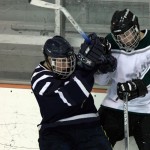 I can tell from the way he explained things, that Michael likes his kids. Heck, the fact that he would ask for advice in an open hockey forum says a lot about how he cares for his kids.
I can tell from the way he explained things, that Michael likes his kids. Heck, the fact that he would ask for advice in an open hockey forum says a lot about how he cares for his kids.
As for his answers, the one thing that troubled me was that his kids might not have been drilled in backchecking basis. Said yet another way, I suspect few of his kids -- or even their parents -- would do more than stand with their mouths wide open if I asked them to define the term backchacking for me.
With all that, Coach B's last note to me explained part of the way he addresses backchecking, saying, "I tell my kids about the other team. If they can't shoot, they can't score. If they can't score, they can't win." And he closes with, "Someday they will put it all together."
Hmmmmmmm... Will they? Really?
To paraphrase my answer to that last paragraph... I just suggested that talking with the kids is only going to go so far. Oh, what he'd told them was right, and it was good stuff to share with a group of youngsters like his. If you think about what he said up there, though, there's not a lot his kids can hang their hats on. I mean, every player -- beginners through pros -- kinda knows those principles, and I'm betting that most of them try to score while also trying to keep their opponents off the scoreboard. But, do those words really guide them in HOW to prevent those enemy goals? I don't think so. (Oho, am I back on that "WHAT plus the HOW" thing again? Maybe.)
With all that, let me give my version, which I suspect is pretty close to what Michael is hoping for his kids. And, to begin, I think he has to talk to his kids about the definition of backchecking...
Up in the bleachers, parents are likely screaming on a turnover, "Backcheck! Backcheck! Backcheck!" If I'm right, what they really mean is for all the kids to skate their buns off coming back towards their own goal -- with no real guidelines, no real rules for what they're to next do...
If I had to define just about any phase of our game, I'd probably need an hour. Still, let's begin with the idea of the closest player to the opposition puckcarrier pressuring him as quickly as possible. Hey, if that works, we might stop the whole rush, and not need to backcheck at all. If it doesn't work, every player on our side has to in a hurry find an enemy player and stick with him. In today's (patty cake?) game it might not work, but I'll usually advise my checking forwards to bump their man upon first finding him, this to slow him a bit.
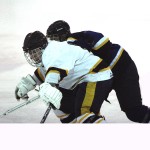 As the opposition rush leaves our zone and moves through the neutral zone, it's kinda man-on-man, or everyone doing their part to help. Two backward skating defensemen would have the puckcarrier and the first open opponent, while our three forwards coming back would have the third attacker, the fourth, and the fifth. All the while our checkers should be moving close to shoulder-to-shoulder with their man (I explain that differently in another post), and in between their man and the puck. Through the neutral zone, things can be played rather loosely, and backcheckers can look to intercept passes.
As the opposition rush leaves our zone and moves through the neutral zone, it's kinda man-on-man, or everyone doing their part to help. Two backward skating defensemen would have the puckcarrier and the first open opponent, while our three forwards coming back would have the third attacker, the fourth, and the fifth. All the while our checkers should be moving close to shoulder-to-shoulder with their man (I explain that differently in another post), and in between their man and the puck. Through the neutral zone, things can be played rather loosely, and backcheckers can look to intercept passes.
Everything changes as the rush enters our defensive zone, though. This is the danger zone, or a lot like American footballers would say, the "red zone". From here onward, coverage must be tight. AND, from here onward, backcheckers moving towards their own net should look to control -- or negate -- their man's stick.
The latter should prevent passes from connecting. And, as play nears the net, checkers should continue controlling their man's stick to prevent tap-ins or rebounds.
When does backchecking end? It ends when the attack is over, and the puck moves away from the net.
Letting Michael B know that I'd be doing an article on troubleshooting hockey backchecking, I told him I'd leave him with one drill that might begin solving his kids' problems...
I told him to take three skaters (of similar color) and line them across the red line.
Put three more skaters (in different colors) lying on their bellies facing toward their net, and not able to see the three behind them.
On, "Go!", he should pass a puck to someone in the back row, and let them attack the net.
At the same time, the three on their bellies have to quickly rise and grab a man each. The challenge is for the backcheckers rising from the prone position to sort out who they can cover -- and not all chase the puck, and they should each stay with their man until the play is over.
When play gets close to the net, Michael should keep harping on the fact that, "Sticks score goals!" In other words, all the kids have to negate their man's stick, thus taking away passes and preventing rebound goals.
Asking the coach if that stuff was clear, he answered, "Makes perfect sense."
CoachChic.com members are lucky, in that I have a four-part video series included in this site, beginning with "Checking — The REAL Definition!", and continuing on with pretty in depth stuff on checking in the offensive zone, backchecking, defensive zone coverage, and so much more. There's also a pretty good post and video on "In hockey defense, know that 'Sticks Score Goals!'", that also includes a few good drills for perfecting that skill.
As for more drills... Michael and others should know that the drill I described up above can be adapted to be used in different areas of the ice. In other words, it could be adapted to help backchecking forwards find and cover their men in the offensive zone, and also from high in the offensive zone and through the neutral zone.
Lastly, I want to thank the young coach for offering me a chance to troubleshoot hockey backchecking for him and his kids. And I also want to offer further help should he need it. Actually, I'd love to field questions on this topic if others would just enter them in the comment boxes below.
PS: Although I've read somewhere that directing kids from the bench isn't a good idea, I beg to differ -- if only somewhat. I didn't yell all that much from my college team's bench, and I surely wouldn't as a pro coach (no one would hear, anyway). Kids in the developmental years are different, however, and they can be helped with short cues, or phrases that have real meaning behind them. So, my kids knew what I meant when I yelled the color of their opponents, as in "Get a red! Get a red!" No long directions, but just a simple cue my players understood to the letter.
Help me help you by entering new questions in our Ask The Coach section.
What We Can Learn from Hockey Penalties
We coaches -- in almost all sports -- might be considered a rather odd lot. We study and study our game, and we analyze and maybe even over-analyze just about every aspect of play. And trust me, that I'm no exception. ;) Back home in Massachusetts, I was (lovingly, I'm sure) referred to by many hockey parents as "The Nutty Professor". Ya, I've been known to come up with some of the wildest drills anyone has ever seen.
Still, I'd never change the approach I've taken in my work. Even a study as outside the box as the following one has proven hugely beneficial -- to my players and to me.
-- Dennis Chighisola
What We Can Learn from Hockey Penalties
I'm guessing it was sometime in the early 1980's when the subject of this post first crossed my mind. I know it was during one of my first seasons as a college head coach, and I can even remember the two players who caused me to think there was a connection between penalties and some other playing difficulties. Actually, both guys were pretty good players. However, one was returning from an injury, while I suspected the other didn't have the kind of stamina I expected. Of course, upperclassmen that they were, and good players that they were, you might imagine that they put up quite a stink when I suggested their playing time might be reduced for an upcoming game. I do recall, however, that I gave both guys a chance once the next game started. The one returning from the injury didn't last too long into the game before he had to call it a night. On the other hand, the guy I suspected of being out of shape at least tried to take a regular shift.
Okay, so the Nutty Professor tends to come out in me when I do something mindless, like driving home from a game -- rehashing and rehashing things in my mind, and trying to make sense of some things that many others might not even consider.
The morning after, I contacted one our team's volunteer stats people, and asked if she could go through all of our games to that point in the season, and provide me with the types of penalties taken by each of our players. On the drive home the previous night, I couldn't help but think about the penalties both of the guys in question had taken. It wasn't that they took a lot -- it was probably a combined total of three, but it was the nature of those penalties that had gotten me into Nutty Professor mode.
Now, think along with me, if you will... I already knew what penalties the suspected out of shape kid had taken in that recent game. However, since his conditioning had seemingly been off for the entire early season, it was his whole body of work that I was really interested in seeing. In other words, if we were 7- or 8-games into our schedule, I had a feeling that all the penalties he'd amassed up through the last game would be similar, and they'd tell a certain story.
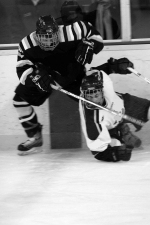 Bingo! Beside that young guy's name was listed calls like hooking, tripping and holding, and he probably had at least two of each. Among knowledgeable hockey coaches, a hooking penalty is frequently seen as a sign of laziness. In other words, instead of hustling and skating his buns off, the player gives less effort than necessary, he coasts, and then just reaches for an opposing puckcarrier with the stick. In my player's case, however, while being out of shape can make one lazy, I believe he was running out of gas and just not able to catch his man. And I quickly saw the other penalties in the same light... My guy reached out often with his stick to take some tripping penalties; and he also lost tussles along the boards, these resulting in holding calls.
Not stopping there, and with the entire roster in front of me, I scanned down to see if I could spot any other unusual groupings of penalties.
Sure enough, another of my players spent time in the box for calls similar to the first guy. I didn't see him being out of shape, however, although I could easily understand why his rather large body and slowness of foot caused him to take a number of hooking and holding penalties. And so was there another young guy who wasn't exactly known for his footwork listed as taking a batch of similar penalties.
Bingo! Beside that young guy's name was listed calls like hooking, tripping and holding, and he probably had at least two of each. Among knowledgeable hockey coaches, a hooking penalty is frequently seen as a sign of laziness. In other words, instead of hustling and skating his buns off, the player gives less effort than necessary, he coasts, and then just reaches for an opposing puckcarrier with the stick. In my player's case, however, while being out of shape can make one lazy, I believe he was running out of gas and just not able to catch his man. And I quickly saw the other penalties in the same light... My guy reached out often with his stick to take some tripping penalties; and he also lost tussles along the boards, these resulting in holding calls.
Not stopping there, and with the entire roster in front of me, I scanned down to see if I could spot any other unusual groupings of penalties.
Sure enough, another of my players spent time in the box for calls similar to the first guy. I didn't see him being out of shape, however, although I could easily understand why his rather large body and slowness of foot caused him to take a number of hooking and holding penalties. And so was there another young guy who wasn't exactly known for his footwork listed as taking a batch of similar penalties.
Ye Old Professor wasn't done there, either. For, with some time to kill, and a couple of pages of stats at my disposal, I scanned down through the rest of our roster to see if I could connect those with other player tendencies.
Oh, could I ever... For example, here are the types of penalties our resident (self proclaimed) goon amassed: roughing, charging, cross-checking, boarding, slashing... Need I say more?
As interesting as all the rest, though, was our second most penalized player, who had totaled only a few less minutes than the team's supposed tough guy. His penalties seemed to be all over the board, with calls like charging, hooking, cross-checking and tripping.
Okay, so you could be wondering what the big deal is here, and how it could be that there is something to be learned from studying a player's penalties. Well...
- First, I think it's important that coaches, parents, players and the media keep statistics in a certain perspective. Professional teams and agents for the pros might like to beat each other over the heads with stats at contract time, but I'm just using whatever I can gather to suggest to me some tendencies, or even some maybes.
- Over the 20-plus years since I first conducted that (very unscientific) study, I've found that the types of penalties players get do give me some insight into what's happening with a given player. At times, I've even been able to use that as evidence in the event I want a guy to make some changes to his game or to his preparations for the game.
- I've discovered that there can be several reasons why a player gets called for certain kinds of penalties. Again, the types of penalties he takes are only helpful in suggesting he has a problem. It's up to the player and me to figure what that problem might be.
- In other words, I have to know the player -- or watch him more closely -- to decide whether penalties like hooking, holding and tripping mean he is injured, out of shape, or maybe just lacking the speed or skills to keep up with quicker or more agile opponents.
- In much the same way, the guy taking all the roughhouse kind of penalties may either be playing selfishly and being overly aggressive, or he might be the type who is trying to hustle and dig but just has subpar body-checking skills or technique.

A Flexible Hockey Forecheck
I like to respond quickly to member requests (hey, being here for YOU is what I and CoachChic.com should be all about).
I mention this because Tim T just wrote and asked, "What are some situations where a coach would have players back off from an aggressive forecheck?"
Ah, what an awesome question, and it's one that I actually wanted to address with my members sometime this month...
-- Dennis Chighisola
A Flexible Hockey Forecheck
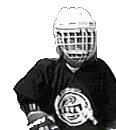 Actually, that title is not the way I usually present this line of thinking to my players. I happen to call it "Facing-up", while I know some other coaches refer to it as the "Logo Forechecking". Both make sense, as you'll soon discover.
Now, in case you don't totally appreciate Tim's question, I think the best way to begin is to share something I witnessed a few years ago while watching one of my grandson's high school hockey games...
Actually, that title is not the way I usually present this line of thinking to my players. I happen to call it "Facing-up", while I know some other coaches refer to it as the "Logo Forechecking". Both make sense, as you'll soon discover.
Now, in case you don't totally appreciate Tim's question, I think the best way to begin is to share something I witnessed a few years ago while watching one of my grandson's high school hockey games...
He played in a pretty high caliber league back then, which not only included a lot of great players, but also a lot of pretty sharp coaches.
Anyway, one evening The Good Guys played a very talented and well coached team from Rhode Island.
Every so often I'd hear some fairly loud communications going on down on the ice below me, this usually happening as the RI team dumped the puck and moved into their forecheck.
It only took a few instances for me to understand what the yelling was all about. You See, if my grandson's team was able to quickly gather the dumped puck, there was the likelihood that they could begin their breakout before the RI group could move into their aggressive forechecking positions.
Now, think about that a little more if you need to... In other words, as Tim T has suggested, an aggressive forecheck is going to get stuck -- or trapped -- any time the opponents are able to start their breakout quicker than the aggressive forecheck can be deployed.
As I recall, the RI team was using a version of the 2-1-2 as their basic aggressive forecheck. However, what I'd hear one or more of their forwards yelling at times was, "One! One!" Yup, upon seeing certain conditions unfolding in front of them, at least one lead forward would alert everyone else as to the need to abandon their aggressive 2-1-2, and to instead move into a more conservative scheme that had only one forward pressuring the puck.
Okay, so you're wondering where the "logo" or "facing-up" designations come in?
Well, as I've heard other coaches say, one good way to determine whether it is safe to be aggressive or not is spot whether the earliest forechecker/s can see the logo on the front of the rival puckcarrier's jersey. Said yet another way, if an enemy puckcarrier has good control of the puck -- and he's already facing-up ice -- as you're moving into the offensive zone, it might not be wise to be aggressive.
 Again, I think the use of the term "logo" is fine. However, as I attempted to teach related principles to my high school prep team a few years back, I wanted whatever key word or phrase I'd use to cover a number of things...
Again, I think the use of the term "logo" is fine. However, as I attempted to teach related principles to my high school prep team a few years back, I wanted whatever key word or phrase I'd use to cover a number of things...
As I mentioned just moments ago, an opponent's good control of the puck is as important in this read as is his posture (like facing-up the ice). I mean, if you can see that player's logo but he's fumbling with a puck in his skates (or whatever), there might still be a chance to check aggressively.
Then, while I've never heard this kind of reading and reacting mentioned by hockey color commentators during television broadcasts, I can assure you that every high level team employs some form of this decision-making. They use it as I've described above, and they'll at least use it while in the midst of a line change.
Of course, the first question I expect from member coaches will have to do with the age groups that might be able to deploy this kind of tactic. So, in my opinion, it should at least be used by teams from Midgets and high schools on up through juniors, colleges and pros.
Could pretty headsy Pee Wees and Bantams use it? I think so. The main criteria, as far as I'm concerned, would be that a team be able to understand and effectively apply two drastically different types of forechecks -- one being aggressive, the other being conservative.
Oh, and one last thing... Within this "Thinking the Game" category, you're going to hear me frequently refer to the need for players to play with balance, and to be able to think and skate at the same time. Ya, as a player moves up the hockey ladder, he or she can't just run around without a purpose. And ultimately, he or she is going to need to read and react to various situations much like I've described here.
Russian Circle Passing - Variations #3, #4, #5
Please see Drill Submission Rules and Help at the bottom of the Free Drills page.
Contributor: Coach from Virginia & Maryland, USA
Drill Category: Skating, Passing, Pass Receiving, Attacking and Goaltending
Please first see the basic set-up of this drill as described under the free Drills section. For, from that basic format, some really awesome offensive and defensive variations are possible. (Click here for: “Russian Circle Passing“.) This coach has added quite a few great variations to the basic drilling. So, I'll let him take it away from here...Russian Circle Passing - Variations #3 Drill Description: Comments: The set up is the same as the basic drill, but the first player starts with a puck and is skating backwards. As he gets to the red line, passes the puck back to the line he came from, and continues backwards until the apex of the circle, where he opens up his stick to get a pass from the other line. He quickly transitions to forward, now attacking the net. Benefits: Players become more aware of the transition space in the neutral zone, and able to transition the puck forward twice in the same drill. Running the drill: - In the basic set-up, skaters are lined-up along the boards and behind a blue line on both sides of the ice. - The drill begins with one player skating backwards (with a puck) around the center face-off circle. Nearing the red line, he passes the puck back to the original line. - Continuing on, he pivots from backwards to forwards near the bottom of the circle, and then receives a pass from the other line. - That player then continues to attack the far goal. http://coachchic2.s3.amazonaws.com/Russian+Circle+-+3.flv
-- Dennis Chighisola
I've altered this coach's variation a bit here, placing a line of defensemen next to each line. In this way, "D" get to handle each rush. (To be honest, I also did this so that the video would be a little clearer.)Benefits: All the previous skills are honed, along with the addition of players getting to work their 1 against 1 skills. Running the drill: - In the basic set-up, skaters are lined-up along the boards and behind a blue line on both sides of the ice. - The drill begins with one player skating backwards (with a puck) around the center face-off circle. Nearing the red line, he passes the puck back to the original line. - The first skater continues on to take a pass (as in the earlier drill), while the second player in the original line (or the red defenseman in my sketch) jumps out to defend against the first skater. http://coachchic2.s3.amazonaws.com/Russian+Circle+-+4.flv
-- Dennis Chighisola
Subscribe to:
Posts (Atom)
